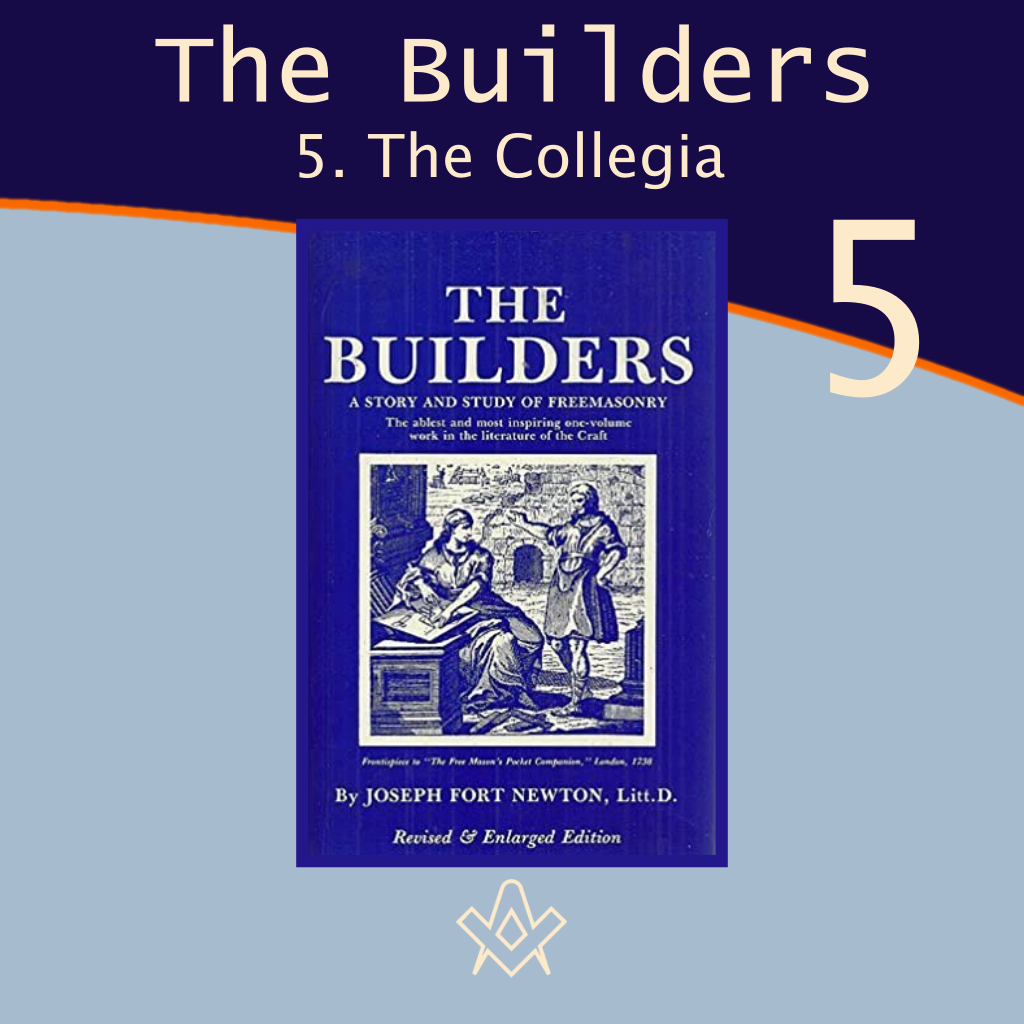In 1915, Joseph Fort Newton’s book, ‘The Builders: A Story and Study of Freemasonry’ was published.
It has become a Masonic classic in as much that it really does lay the foundations of knowledge for us to build upon.
This society was called the Dionysian Artificers, as Bacchus was supposed to be the inventor of building theaters; and they performed the Dionysian festivities. From this period, the Science of Astronomy which had given rise to the Dionysian rites, became connected with types taken from the art of building. The Ionian societies . . . extended their moral views, in con-junction with the art of building, to many useful purposes, and to the practice of acts of benevolence. They had significant words to distinguish their members; and for the same purpose they used emblems taken from the art of building.
— JOSEPH DA COSTA, Dionysian Artificers.
We need not then consider it improbable, if in the dark centuries when the Roman empire was dying out, and its glorious temples falling into ruin; when the arts and sciences were falling into disuse or being enslaved; and when no place was safe from persecution and warfare, the guild of the Architects should fly for safety to almost the only free spot in Italy; and here, though they could no longer practice their craft, they preserved the legendary knowledge and precepts which, as history implies, came down to them through Vitruvius from older sources, some say from Solomon’s builders themselves.
— LEADER SCOTT, The Cathedral Builders.
Chapter 5 – The Collegia
I
So far, in our study we have found that from earliest time architecture was related to religion; that the working tools of the builder were emblems of moral truth; that there were great secret orders using the Drama of Faith as a rite of initiation; and that a hidden doctrine was kept for those accounted worthy, after trial, to be entrusted with it.
Secret societies, born of the nature and need of man, there have been almost since recorded history began [1]; but as yet we have come upon no separate and distinct order of builders.
For aught we know there may have been such in plenty, but we have no intimation, much less a record, of the fact. That is to say, history has a vague story to tell us of the earliest orders of the builders.
However, it is more than a mere plausible inference that from the beginning architects were members of secret orders; for, as we have seen, not only the truths of religion and philosophy, but also the facts of science and the laws of art, were held as secrets to be known only to the few.
This was so, apparently without exception, among all ancient peoples; so much so, indeed, that we may take it as certain that the builders of old time were initiates.
Of necessity, then, the arts of the craft were secrets jealously guarded, and the architects themselves, while they may have employed and trained ordinary workmen, were men of learning and influence.
Such glimpses of early architects as we have confirm this inference, as, for example, the noble hymn to the Sun-god written by Suti [Suty] and Hor, two architects employed by Amenhotep III, of Egypt. [2]
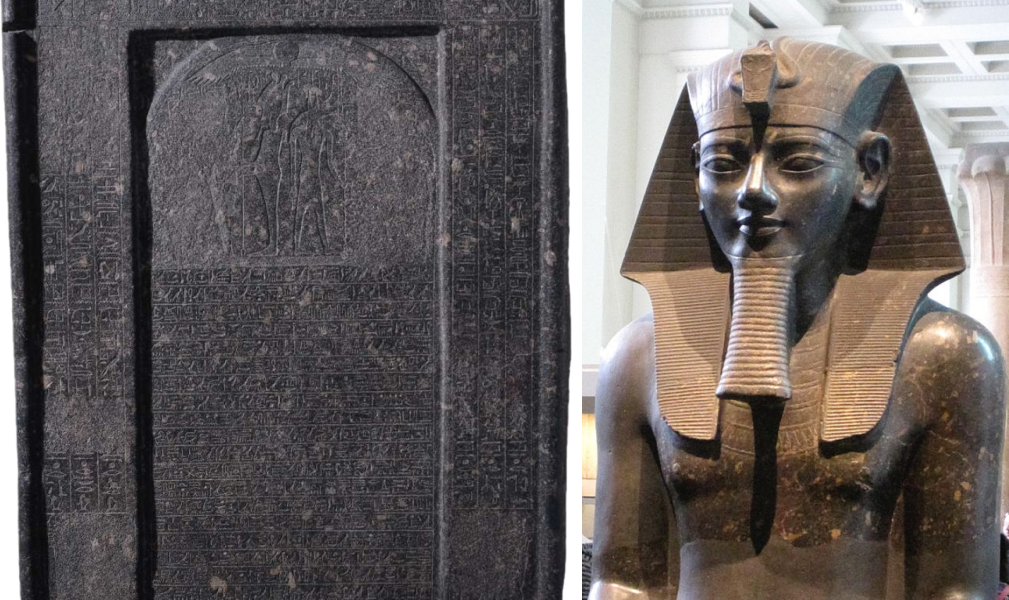
Left: Granite stela of Hor and Suty © The Trustees of the British Museum
Right: Amenhotep III also known as Amenhotep the Magnificent or Amenhotep the Great, was the ninth pharaoh of the Eighteenth Dynasty.
IMAGE LINKED: wikimedia Attribution 4.0 International (CC BY 4.0)
Just when the builders began to form orders of their own no one knows, but it was perhaps when the Mystery-cults began to journey abroad into other lands.
What we have to keep in mind is that all the arts had their home in the temple, from which, as time passed, they spread out fan-wise along all the paths of culture.
Keeping in mind the secrecy of the laws of building, and the sanctity with which all science and art were regarded, we have a key whereby to interpret the legends woven about the building of the temple of Solomon.
Few realize how high that temple on Mount Moriah towered in the history of the olden world, and how the story of its building haunted the legends and traditions of the times following.
Of these legends there were many, some of them wildly improbable, but the persistence of the tradition, and its consistency withal, despite many variations, is a fact of no small moment.
Nor is this tradition to be wondered at, since time has shown that the building of the temple at Jerusalem was an event of world-importance, not only to the Hebrews, but to other nations, more especially the Phoenicians.
The histories of both peoples make much of the building of the Hebrew temple, of the friendship of Solomon and Hiram I, of Tyre, and of the harmony between the two peoples; and Phoenician tradition has it that Solomon presented Hiram with a duplicate of the temple, which was erected in Tyre. [3]
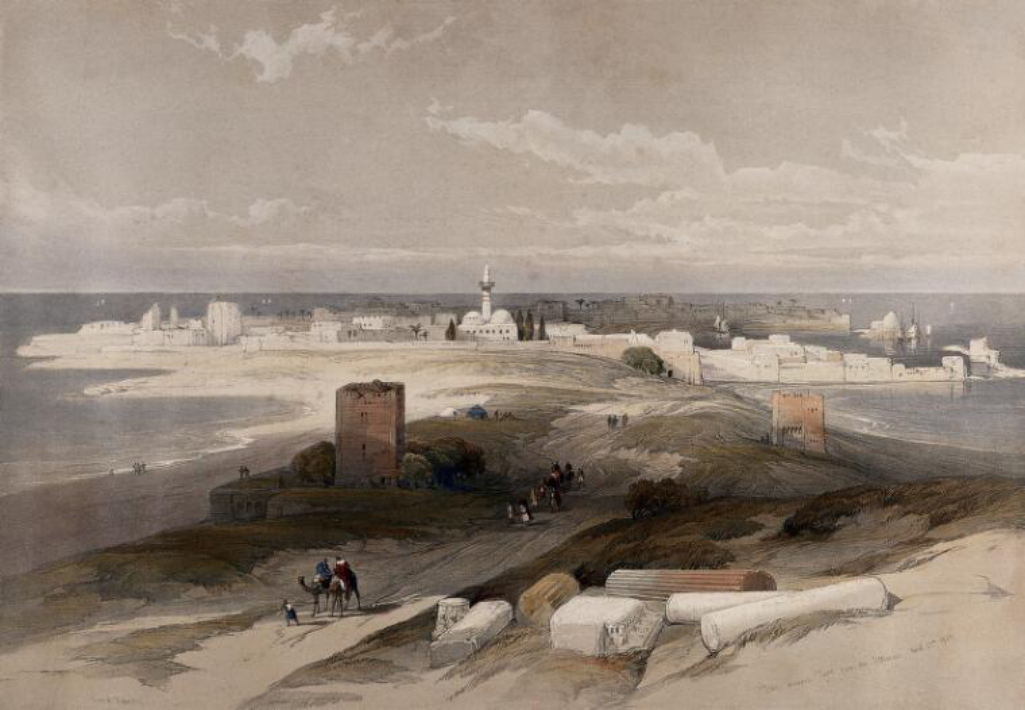
The ancient city of Tyre, taken from the isthmus. Coloured lithograph by Louis Haghe after David Roberts, 1843..
IMAGE LINKED: Wellcome Collection. Attribution 4.0 International (CC BY 4.0)
Clearly, the two nations were drawn closely together, and this fact carried with it a mingling of religious influences and ideas, as was true between the Hebrews and other nations, especially Egypt and Phoenicia, during the reign of Solomon.
Now the religion of the Phoenicians at this time, as all agree, was the Egyptian religion in a modified form, Dionysius having taken the role of Osiris in the drama of faith in Greece, Syria, and Asia Minor.
Thus we have the Mysteries of Egypt, in which Moses was learned, brought to the very door of the temple of Solomon, and that, too, at a time favorable to their impress.
The Hebrews were not architects, and it is plain from the records that the temple—and, indeed, the palaces of Solomon—were designed and erected by Phoenician builders, and for the most part by Phoenician workmen and materials.
Josephus adds that the architecture of the temple was of the style called Grecian. So much would seem to be fact, whatever may be said of the legends flowing from it.
If, then, the laws of building were secrets known only to initiates, there must have been a secret Order of architects who built the temple of Solomon.
Who were they? They were almost certainly the Dionysian Artificers —not to be confused with the play-actors called by the same name later—an Order of builders who erected temples, stadia, and theaters in Asia Minor, and who were at the same time an order of the Mysteries under the tutelage of Bacchus before that worship declined, as it did later in Athens and Rome, into mere revelry. [4]
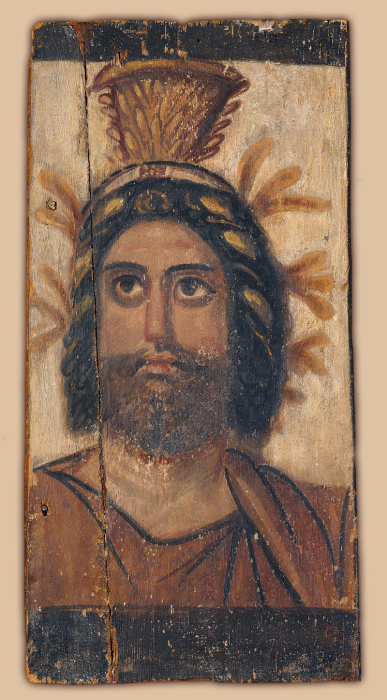
Painted wood panel depicting Serapis, who was considered the same god as Osiris, Hades, and Dionysus in Late Antiquity. Second century AD.
IMAGE LINKED: wikimedia Attribution 4.0 International (CC BY 4.0)
As such, they united the art of architecture with the old Egyptian drama of faith, representing in their ceremonies the murder of Dionysius by the Titans and his return to life.
So that, blending the symbols of Astronomy with those of Architecture, by a slight change made by a natural process, how easy for the master-artist of the temple-builders to become the hero of the ancient drama of immortality. [5]
Whether or not this fact can be verified from history, such is the form in which the tradition has come down to us, surviving through long ages and triumphing over all vicissitude. [6]
Secret orders have few records and their story is hard to tell, but this account is perfectly in accord with the spirit and setting of the situation, and there is neither fact nor reason against it.
While this does not establish it as true historically, it surely gives it validity as a prophecy, if nothing more. [7]
After all, then, the tradition that Masonry, not unlike the Masonry we now know, had its origin while the temple of King Solomon was building, and was given shape by the two royal friends, may not be so fantastic as certain superior folk seem to think it.
How else can we explain the fact that when the Knights of the Crusades went to the Holy Land they came back a secret, oath-bound fraternity?
Also, why is it that, through the ages, we see bands of builders coming from the East calling themselves “sons of Solomon,” and using his interlaced triangle-seal as their emblem?
Strabo, as we have seen, traced the Dionysiac builders eastward into Syria, Persia, and even India. They may also be traced westward.
Traversing Asia Minor, they entered Europe by way of Constantinople, and we follow them through Greece to Rome, where already several centuries before Christ we find them bound together in corporations called Collegia.
These lodges flourished in all parts of the Roman Empire, traces of their existence having been discovered in England as early as the middle of the first century of our era.
II
Krause was the first to point out a prophecy of Masonry in the old orders of builders, following their footsteps—not connectedly, of course, for there are many gaps—through the Dionysiac fraternity of Tyre, through the Roman Collegia, to the architects and Masons of the Middle Ages.
Since he wrote, however, much new material has come to light, but the date of the advent of the builders in Rome is still uncertain.
Some trace it to the very founding of the city, while others go no further back than King Numa, the friend of Pythagoras. [8]
By any account, they were of great antiquity, and their influence in Roman history was far-reaching.
They followed the Roman legions to remote places, building cities, bridges, and temples, and it was but natural that Mithra, the patron god of soldiers, should have influenced their orders.
Of this an example may be seen in the remains of the ancient Roman villa at Morton, on the Isle of Wight. [9] [https://bradingromanvilla.org.uk]
As Rome grew in power and became a vast, all-embracing empire, the individual man felt, more and more, his littleness and loneliness.
This feeling, together with the increasing specialization of industry, begat a passion for association, and Collegia of many sorts were organized.
Even a casual glance at the inscriptions, under the heading Artes et Opificia, will show the enormous development of skilled handicrafts, and how minute was their specialization.
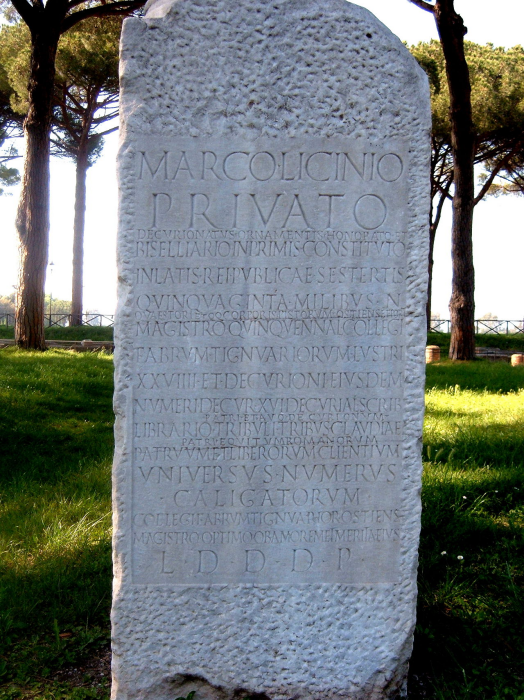
Inscription (CIL 14.374) from Ostia Antica commemorating a Marcus Licinius Privatus, who was magister of a college of carpenters. By Kleuske – Own work
IMAGE LINKED: wikimedia Attribution 4.0 International (CC BY 4.0)
Every trade soon had its secret order, or union, and so powerful did they become that the emperors found it necessary to abolish the right of free association.
Yet even such edicts, though effective for a little time, were helpless as against the universal craving for combination.
Ways were easily found whereby to evade the law, which had exempted from its restrictions orders consecrated by their antiquity or their religious character.
Most of the Collegia became funerary and charitable in their labors, humble folk seeking to escape the dim, hopeless obscurity of plebeian life, and the still more hopeless obscurity of death.
Pathetic beyond words are some of the inscriptions telling of the horror and loneliness of the grave, of the day when no kindly eye would read the forgotten name, and no hand bring offerings of flowers.
Each collegium held memorial services, and marked the tomb of its dead with the emblems of its trade: if a baker, with a loaf of bread; if a builder, with a square, compasses, and the level.
From the first the Colleges of Architects seem to have enjoyed special privileges and exemptions, owing to the value of their service to the state, and while we do not find them called Free-masons they were such in law and fact long before they wore the name.
They were permitted to have their own constitutions and regulations, both secular and religious.
In form, in officers, in emblems a Roman Collegium resembled very much a modern Masonic Lodge.
For one thing, no College could consist of less than three persons, and so rigid was this rule that the saying, “three make a college,” became a maxim of law. Each College was presided over by a Magister, or Master, with two decuriones, or wardens, each of whom extended the commands of the Master to “the brethren of his column.”
There were a secretary, a treasurer, and a keeper of archives, and, as the colleges were in part religious and usually met near some temple, there was a sacerdos, or, as we would say, a priest, or chaplain.
The members were of three orders, not unlike apprentices, fellows, and masters, or colleagues. What ceremonies of initiation were used we do not know, but that they were of a religious nature seems certain, as each College adopted a patron deity from among the many then worshiped.
Also, as the Mysteries of Isis and Mithra ruled the Roman world by turns, the ancient drama of eternal life was never far away.
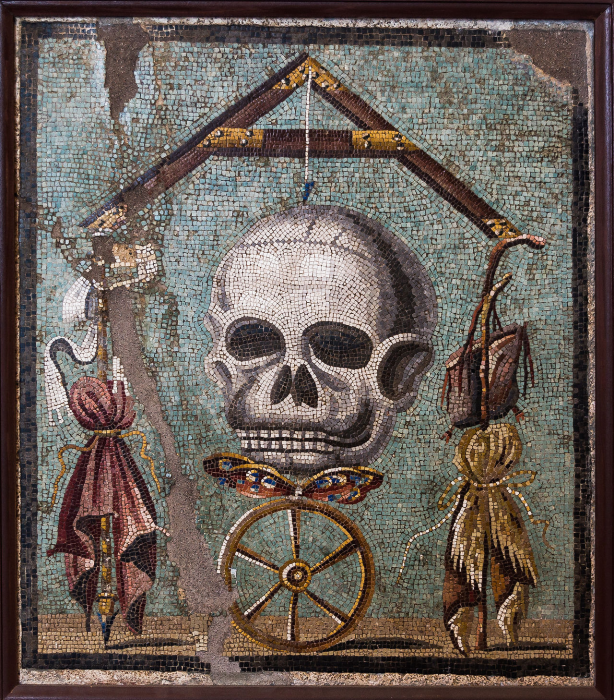
Of the emblems of the Collegia, it is enough to say that here again we find the simple tools of the builder used as teachers of truth for life and hope in death.
Upon a number of sarcophagi, still extant, we find carved the square, the compasses, the cube, the plummet, the circle, and always the level.
There is, besides, the famous Collegium uncovered at the excavation of Pompeii in 1878, having been buried under the ashes and lava of Mount Vesuvius since the year 79 A. D.
It stood near the Tragic Theater, not far from the Temple of Isis, and by its arrangement, with two columns in front and interlaced triangles on the walls, was identified as an ancient lodge room.
Upon a pedestal in the room was found a rare bit of art, unique in design and exquisite in execution, now in the National Museum at Naples.
It is described by S. R. Forbes, in his Rambles in Naples, as follows:
It is a mosaic table of square shape, fixed in a strong wooden frame.
The ground is of grey green stone, in the middle of which is a human skull, made of white, grey, and black colors.
In appearance the skull is quite natural. The eyes, nostrils, teeth, ears, and coronal are all well executed.
Above the skull is a level of colored wood, the points being of brass; and from the top to the point, by a white thread, is suspended a plumb-line.
Below the skull is a wheel of six spokes, and on the upper rim of the wheel there is a butterfly with wings of red, edged with yellow; its eyes blue. . .
On the left is an upright spear, resting on the ground; from this there hangs, attached to a golden cord, a garment of scarlet, also a purple robe; whilst the upper part of the spear is surrounded by a white braid of diamond pattern.
To the right is a gnarled thorn stick, from which hangs a coarse, shaggy piece of cloth in yellow, grey, and brown colors, tied with a ribbon; and above it is a leather knapsack. . .
Evidently this work of art, by its composition, is mystical and symbolical.
No doubt; and for those who know the meaning of these emblems there is a feeling of kinship with those men, long since fallen into dust, who gathered about such an altar.
They wrought out in this work of art their vision of the old-worn pilgrim way of life, with its vicissitude and care, the level of mortality to which all are brought at last by death, and the winged, fluttering hope of man.
Always a journey with its horny staff and wallet, life is sometimes a battle needing a spear, but for him who walks uprightly by the plumb-line of rectitude, there is a true and victorious hope at the end.
Of wounds and sore defeat
I made my battle stay,
Winged sandals for my feet
I wove of my delay.
Of weariness and fear
I made a shouting spear,
Of loss and doubt and dread
And swift on-coming doom
I made a helmet for my head,
And a waving plume.
III
Christianity, whose Founder was a Carpenter, made a mighty appeal to the working classes of Rome.
As Deissmann and Harnack have shown, the secret of its expansion in the early years was that it came down to the man in the street with its message of hope and joy.
Its appeal was hardly heard in high places, but it was welcomed by the men who were weary and heavy ladened.
Among the Collegia it made rapid progress, its Saints taking the place of pagan deities as patrons, and its spirit of love welding men into closer, truer union.
When Diocletian determined to destroy Christianity, he was strangely lenient and patient with the Collegia, so many of whose members were of that faith.
Not until they refused to make a statue of Æsculapius did he vow vengeance and turn on them, venting his fury.
In the persecution that followed four Master Masons and one humble apprentice suffered cruel torture and death, but they became the Four Crowned Martyrs, the story of whose heroic fidelity unto death haunted the legends of later times. [10]
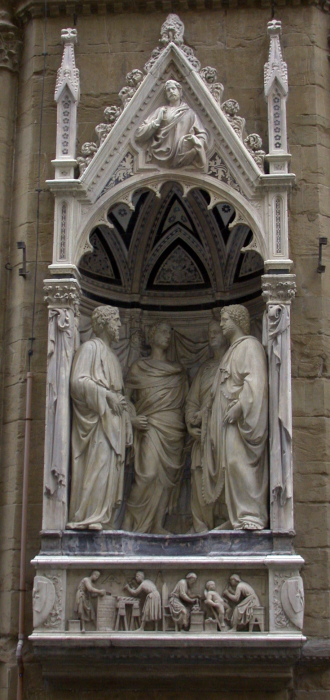
The Four Crowned Saints. Statue commissioned by the Arte dei Maestri di Pietra e Legname (guild of wood and stone cutters). Orsanmichele, Florence
IMAGE LINKED: wikimedia Attribution 4.0 International (CC BY 4.0)
They were the patron saints alike of Lombard and Tuscan builders, and, later, of the working Masons of the Middle Ages, as witness the poem in their praise in the oldest record of the Craft, the Regius MS.
With the breaking up of the College of Architects and their expulsion from Rome, we come upon a period in which it is hard to follow their path.
Happily the task has been made less baffling by recent research, and if we are unable to trace them all the way much light has been let into the darkness.
Hitherto there has been a hiatus also in the history of architecture between the classic art of Rome, which is said to have died when the Empire fell to pieces, and the rise of Gothic art.
Just so, in the story of the builders one finds a gap of like length, between the Collegia of Rome and the cathedral artists.
While the gap cannot, as yet, be perfectly bridged, much has been done to that end by Leader Scott in The Cathedral Builders: The Story of a Great Masonic Guild—a book itself a work of art as well as of fine scholarship.
Her thesis is that the missing link is to be found in the Magistri Comacini [Comacine Masters] a guild of architects who, on the break-up of the Roman Empire, fled to Comacina, a fortified island in Lake Como, and there kept alive the traditions of classic art during the Dark Ages; that from them were developed in direct descent the various styles of Italian architecture; and that, finally, they carried the knowledge and practice of architecture and sculpture into France, Spain, Germany, and England.
Such a thesis is difficult, and, from its nature, not susceptible of absolute proof, but the writer makes it as certain as anything can well be.
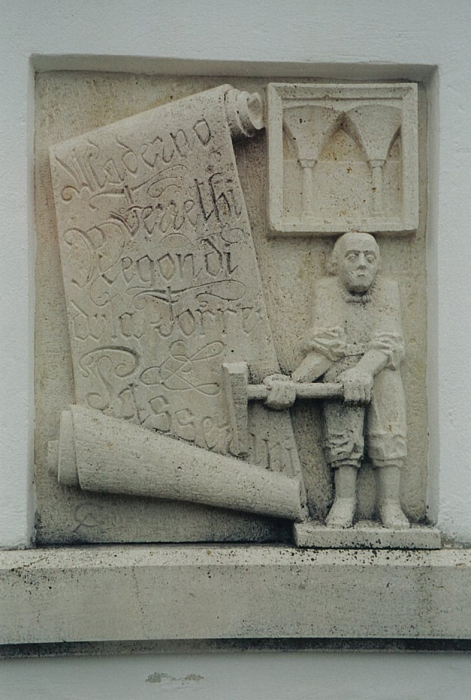
Stone relief carving of the Italian Master in Kaisersteinbruch. Scroll with the names Maderno, Ferrethi, Regondi, della Torre and Passerini, while to the upper right is a quotation from Neugebäude Castle.
IMAGE LINKED: wikimedia Attribution 4.0 International (CC BY 4.0)
While she does not positively affirm that the Comacine Masters were the veritable stock from which the Freemasonry of the present day sprang, “we may admit,” she says, “that they were the link between the classic Collegia and all other art and trade Guilds of the Middle Ages.
They were Free-masons because they were builders of a privileged class, absolved from taxes and servitude, and free to travel about in times of feudal bondage.”
The name Free-mason—Libera muratori—may not actually have been used thus early, but the Comacines were in fact free builders long before the name was employed—free to travel from place to place, as we see from their migrations; free to fix their own prices, while other workmen were bound to feudal lords, or by the Statutes of Wages.
The author quotes in the original Latin an Edict of the Lombard King Rothari, dated November 22, 643, in which certain privileges are confirmed to the Magistri Comacini and their colligantes.
From this Edict it is clear that it is no new order that is alluded to, but an old and powerful body of Masters capable of acting as architects, with men who executed work under them.
For the Comacines were not ordinary workmen, but artists, including architects, sculptors, painters, and decorators, and if affinities of style left in stone be adequate evidence, to them were due the changing forms of architecture in Europe during the cathedral-building period.
Everywhere they left their distinctive impress in a way so unmistakable as to leave no doubt.
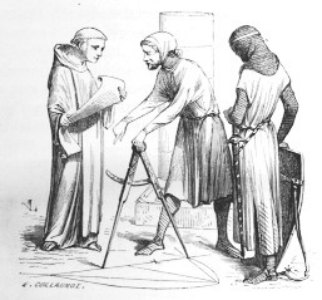
Under Charlemagne the Comacines began their many migrations, and we find them following the missionaries of the church into remote places, from Sicily to Britain, building churches.
When Augustine went to convert the British, the Comacines followed to provide shrines, and Bede, as early as 674, in mentioning that builders were sent for from Gaul to build the church at Wearmouth, uses phrases and words found in the Edict of King Rothari.
For a long time the changes in style of architecture, appearing simultaneously everywhere over Europe, from Italy to England, puzzled students. [11]
Further knowledge of this powerful and widespread order explains it. It also accounts for the fact that no individual architect can be named as the designer of any of the great cathedrals.
Those cathedrals were the work, not of individual artists, but of an order who planned, built, and adorned them.
In 1355 the painters of Siena seceded, as the German Masons did later, and the names of individual artists who worked for fame and glory begin to appear; but up to that time the Order was supreme.
Artists from Greece and Asia Minor, driven from their homes, took refuge with the Comacines, and Leader Scott finds in this order a possible link, by tradition at least, with the temple of Solomon.
At any rate, all through the Dark Ages the name and fame of the Hebrew king lived in the minds of the builders.
An inscribed stone, dating from 712, shows that the Comacine Guild was organized as Magistri and Discipuli, under a Gastaldo, or Grand Master, the very same terms as were kept in the lodges later.
Moreover, they called their meeting places loggia, a long list of which the author recites from the records of various cities, giving names of officers, and, often, of members.
They, too, had their masters and wardens, their oaths, tokens, grips, and passwords which formed a bond of union stronger than legal ties.
They wore white aprons and gloves, and revered the Four Crowned Martyrs of the Order. Square, compasses, level, plumb-line, and arch appear among their emblems.
“King Solomon’s Knot” was one of their symbols, and the endless, interwoven cord, symbol of Eternity which has neither beginning nor end, was another.
Later, however, the Lion’s Paw seems to have become their chief emblem. From illustrations given by the author they are shown in their regalia, with apron and emblems, clad as the keepers of a great art and teaching of which they were masters.
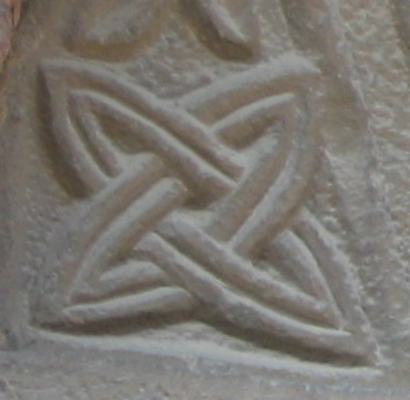
Solomon’s Knot carving, Almenno San Bartolomeo (Italy)
IMAGE LINKED: wikimedia Attribution 4.0 International (CC BY 4.0)
Here, of a truth, is something more than prophecy, and those who have any regard for facts will not again speak lightly of an order having such ancestors as the great Comacine Masters.
Had Fergusson known their story, he would not have paused in his History of Architecture to belittle the Free-masons as incapable of designing a cathedral, while puzzling the while as to who did draw the plans for those dreams of beauty and prayer.
Hereafter, if any one asks to know who uplifted those massive piles in which was portrayed the great drama of mediaeval worship, he need not remain uncertain.
With the decline of Gothic architecture the order of Free-masons also suffered decline, as we shall see, but did not cease to exist—continuing its symbolic tradition amidst varying, and often sad, vicissitude until 1717, when it became a fraternity teaching spiritual faith by allegory and moral science by symbols.
Footnotes
references
[1] Primitive Secret Societies, by H. Webster; Secret Societies of all Ages and Lands, by W. C. Heckethorn.
[2] We may add the case of Weshptah, one of the viziers of the Fifth Dynasty in Egypt, about 2700 B. C., and also the royal architect, for whom the great tomb was built, endowed, and furnished by the king (Religion in Egypt, by Breasted, lecture ii); also the statue of Semut [Senemut], chief of Masons under Queen Hatasu [Hatshepsut], now in Berlin.
[3] Historians His. World, vol. ii, chap. iii. Josephus gives an elaborate account of the temple, including the correspondence between Solomon and Hiram of Tyre (Jewish Antiquities, bk. viii, chaps. 2-6).
[4] Symbolism of Masonry, Mackey, chap. vi; also in Mackey’s Encyclopedia of Masonry, both of which were drawn from History of Masonry, by Laurie, chap. i; and Laurie in turn derived his facts from a Sketch for the History of the Dionysian Artificers, A Fragment, by H. J. Da Costa (1820). Why Waite and others brush the Dionysian architects aside as a dream is past finding out in view of the evidence and authorities put; forth by Da Costa, nor do they give any reason for so doing. “Lebedos was the seat and assembly of the Dionysian Artificers, who inhabit Ionia to the Hellespont; there they had annually their solemn meetings and festivities in honor of Bacchus,” wrote Strabo (lib. xiv, 921). They were a secret society having signs and words to distinguish their members (Robertson’s Greece), and used emblems taken from the art of building (Eusebius, de Prep. Evang. iii, c. 12). They entered Asia Minor and Phoenicia fifty years before the temple of Solomon was built, and Strabo traces them on into Syria, Persia, and India. Surely here are facts not to be swept aside as romance because, forsooth, they do not fit certain theories. Moreover, they explain many things, as we shall see.
[5] Rabbinic legend has it that all the workmen on the temple were killed, so that they should not build another temple devoted to idolatry (Jewish Encyclopedia, article “Freemasonry”). Other legends equally absurd cluster about the temple and its building, none of which is to be taken literally. As a fact, Hiram the architect, or rather artificer in metals, did not lose his life, but, as Josephus tells us, lived to good age and died at Tyre. What the legend is trying to tell us, however, is that at the building of the temple the Mysteries mingled with Hebrew faith, each mutually influencing the other.
[6] Strangely enough, there is a sect or tribe called the Druses, now inhabiting the Lebanon district, who claim to be not only the descendants of the Phoenicians, but the builders of King Solomon’s temple. So persistent and important among them is this tradition that their religion is built about it—if indeed it be not something more than a legend. They have Khalwehs, or temples, built after the fashion of lodges, with three degrees of initiation, and, though an agricultural folk, they use signs and tools of building as emblems of moral truth. They have signs, grips, and passwords for recognition. In the words of their lawgiver, Hamze, their creed reads: “The belief in the Truth of One God shall take the place of Prayer; the exercise of brotherly love shall take the place of Fasting; and the daily practice of acts of Charity shall take the place of Alms-giving.” Why such a people, having such a tradition? Where did they get it? What may this fact set in the fixed and changeless East mean? (See the essay of Hackett Smith on “The Druses and Their Relation to Freemasonry,” and the discussion following, Ars Quatuor Coronatorum, iv. 7-19.)
[7] Rawlinson, in his History of Phoenicia, says the people “had for ages possessed the mason’s art, it having been brought in very early days from Egypt.” Sir C. Warren found on the foundation stones at Jerusalem Mason’s marks in Phoenician letters (A. Q. C., ii, 125; iii, 68).
[8] See essay on “A Masonic Built City,” by S. R. Forbes, a study of the plan and building of Rome, Ars Quatuor Coronatorum, iv, 86. As there will be many references to the proceedings of the Coronatorum Lodge of Research, it will be convenient hereafter to use only its initials, A. Q. C., in behalf of brevity. For an account of the Collegia in early Christian times, see Roman Life from Nero to Aurelius, by Dill (bk. ii, chap. iii); also De Collegia, by Mommsen. There is an excellent article in Mackey’s Encyclopedia of Freemasonry, and Gould, His. Masonry, vol. i, chap. i.
[9] See Masonic Character of Roman Villa at Morton, by J. F. Crease (A. Q. C., iii, 38-59).
[10] Their names were Claudius, Nicostratus, Simphorianus, Castorius, and Simplicius. Later their bodies were brought from Rome to Toulouse where they were placed in a chapel erected in their honor in the church of St. Sernin (Martyrology, by Du Saussay). They became patron saints of Masons in Germany, France, and England (A. Q. C., xii, 196). In a fresco on the walls of the church of St. Lawrence at Rotterdam, partially preserved, they are painted with compasses and trowel in hand. With them, however, is another figure, clad in oriental robe, also holding compasses, but with a royal, not a martyr’s, crown. Is he Solomon? Who else can he be? The fresco dates from 1641, and was painted by F. Wounters (A. Q. C., xii, 202). Even so, those humble workmen, faithful to their faith, became saints of the church, and reign with Solomon! Once the fresco was whitewashed, but the coating fell off and they stood forth with compasses and trowel as before.
[11] History of Middle Ages, Hallam, vol. ii, 547.
Article by: Joseph Fort Newton
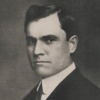
Rev. Newton (1880–1950) , was an American Baptist minister, authored a number of masonic books, including his best-known works, The Builders, published in 1914, and The Men’s House, published in 1923.
He received the third degree of Freemasonry on May 28, 1902 in Friendship Lodge No. 7, Dixon, Illinois, later affiliating with Mt. Hermon Lodge No. 263, Cedar Rapids, Iowa.
He also served as Grand Chaplain of the Grand Lodge of Iowa from 1911 to 1913 and Grand Prelate of the Grand Encampment of Knights Templar.
The Builders has been called "an outstanding classic in Masonic literature offering the early history of Freemasonry."
Recent Articles: The Builders by Joseph Fort Newton
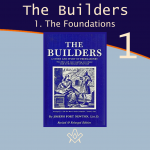 The Builders – 1 The Foundations Chapter 1. The Foundations Explore an outstanding classic in Masonic literature - an exposition of the early history and symbolism of Freemasonry – from the foundations upwards. |
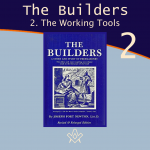 The Builders – 2 The Working Tools Chapter 2. The Working Tools - Explore an outstanding classic in Masonic literature - an exposition of the early history and symbolism of Freemasonry – from the foundations upwards. |
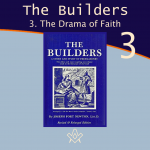 The Builders – 3 The Drama of Faith Chapter 3. The Drama of Faith - Explore an outstanding classic in Masonic literature - an exposition of the early history and symbolism of Freemasonry – from the foundations upwards. |
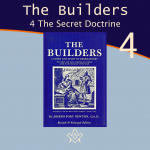 The Builders – 4 The Secret Doctrine Chapter 4. The Secret Doctrine - Explore an outstanding classic in Masonic literature - an exposition of the early history and symbolism of Freemasonry – from the foundations upwards. By Joseph Fort Newton |
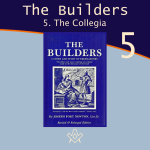 Chapter 5. The Collegia - If the laws of building were secrets known only to initiates, there must have been a secret Order of architects who built the temple of Solomon. Who were they? |
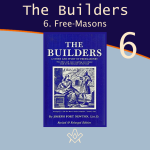 The Builders – 6 The Free-Masons Chapter 6. the Free-Masons - an examination into the history of the medieval guilds, their charges and regulations that form the base for the allegories and symbols in our modern versions of masonic craft ritual. By Joseph Fort Newton |
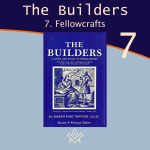 Chapter 7. the Fellowcrafts - an examination into the history of the medieval guilds, their charges and regulations that form the base for the allegories and symbols in our modern versions of masonic craft ritual. By Joseph Fort Newton |
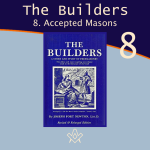 The Builders – 8 Accepted Masons Chapter 8. Accepted Masons - an examination into the history of accepted masons, and why did soldiers, scholars, antiquarians, clergymen, lawyers, and even the nobility ask to be accepted as members of the order of Free-masons? By Joseph Fort Newton |
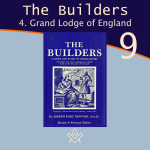 The Builders – 9 Grand Lodge of England Chapter 9. Grand Lodge of England - From every point of view, the organization of the Grand Lodge of England, in 1717, was a significant and far-reaching event. By Joseph Fort Newton |
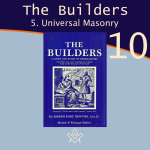 The Builders – 10 Universal Masonry Chapter 10. Universal Masonry - Henceforth, the Masons of England were no longer a society of handicraftsmen, but an association of men of all orders and every vocation, as also of almost every creed, |
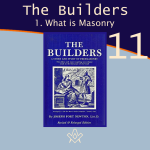 The Builders – 11 What is Masonry Chapter 11 "Masonry is the activity of closely united men who, employing symbolical forms borrowed principally from the mason's trade and from architecture, work for the welfare of mankind, striving morally to ennoble themselves and others, and thereby to bring about a universal league of mankind, which they aspire to exhibit even now on a small scale." |
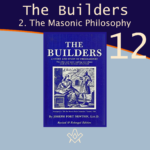 The Builders – 12 The Masonic Philosophy Chapter 12 When we look at Masonry in this large and mellow light, it is like a stately old cathedral, gray with age, rich in associations, its steps worn by innumerable feet of the living and the dead—not piteous, but strong and enduring. By Joseph Fort Newton |
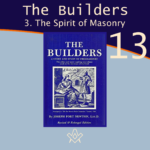 The Builders – 13 The Spirit of Masonry Chapter 13 Masonry is Friendship—friendship, first, with the great Companion, of whom our own hearts tell us, who is always nearer to us than we are to our-selves, and whose inspiration and help is the greatest fact of human experience. |
masonic knowledge
to be a better citizen of the world
share the square with two brothers

click image to open email app on mobile device



